ABC broadcaster behind first coverage of Mardi Gras and Compass
By Noel Debien
WILLIAM VAUGHAN HINTON: 1933 - 2024
“From the time I boarded a train to Toowoomba in 1948 to the day I walked into a fire brigade station in 2008, I have walked through doors which did not reveal what was behind them. This tendency has defined my life.”
Vaughan Hinton’s train journey in 1948 led him through the doors of the Toowoomba Chronicle and his first reporting assignments. Forty-six years later, he would open another momentous door in overseeing the very first broadcast of the Sydney Gay and Lesbian Mardi Gras as ABC executive producer.
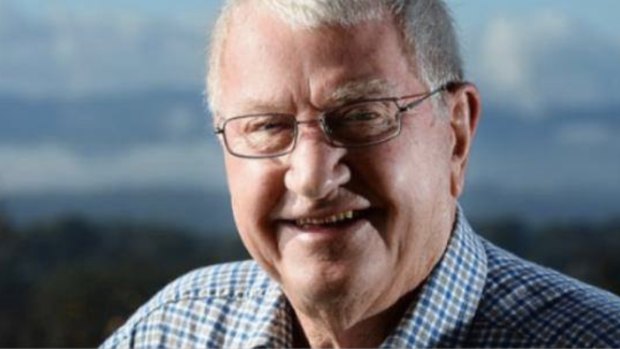
Vaughan Hinton was honoured for his contribution to national broadcasting.
The Mardi Gras was surrounded by a political furore, editorial arguments, technical challenges and a bomb threat to the ABC. Vaughan ensured the program went to air. Next morning, the then head of the ABC congratulated Vaughan on the “biggest audience ABC TV had ever had at that time – 2.5 million”.
Vaughan Hinton was an innovator. In 1986, he had been appointed ABC-TV executive producer for all TV religious programs, Indigenous programs and coverage of significant national events. One morning in 1988, Hinton writes that he “received a call from the managing director, David Hill, to get over to his office as soon as possible.”
Vaughan thought he was about to be clobbered. His tea-cup was rattling in its saucer. At that meeting, Hill and the then head of the ABC’s religious programs were in serious conflict over a negative media report about ABC religion. Soon after, David Hill said to Vaughan, “You have put in a suggestion that you should make an hour-long program for television each week … you can have it.”
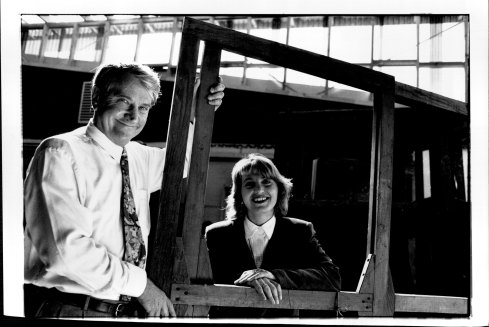
Vaughan Hinton as executive producer for Compass, with presenter Christina Koutsoukas in 1994.Credit: Sally Mayma
So Vaughan opened the door on the creation of the Compass TV program, which first aired in 1988, and some 37 years later is one of the ABC’s longest running TV programs. In Compass, he sought to develop a uniquely Australian program in which the spirituality, religion and values of Australians were examined and interrogated by a national broadcaster with editorial independence from religious organisations.
Vaughan, when writing for the Australian Religion Studies Review, noted that “ABC boards have concluded that while the ABC should “explore developments in religion”, the ABC should “not promote any particular theology or form of religious expression”. As a result, unlike the then approach of the BBC, in Compass, the ABC sought not to favour any “established” church but rather independently report on the variety of religious experiences in Australia.
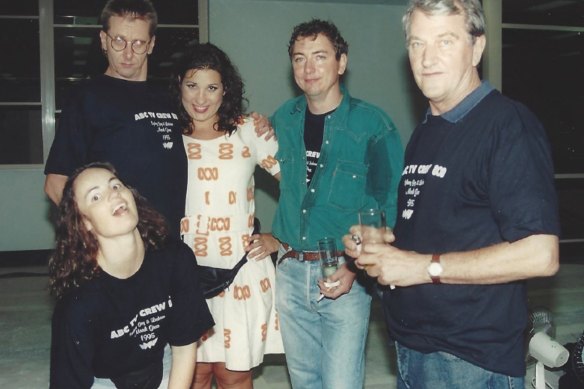
Vaughan Hinton with Elle McFeast other ABC staff from the 1995 Mardi Gras Parade.
Hinton believed that “people encounter the real issues through their ordinary lives – not through dogmas or doctrines – and how they deal with those issues is the Australian way of being religious”. As well as covering the stories of believers and adherents of the country’s various faith traditions, to reflect the breadth of Australian experience, the program was to include people who opposed particular religious doctrines, who were shunned by certain religious bodies, or who argued against religious positions.
Vaughan also oversaw the creation of the ABC’s Indigenous program unit, recruiting Aboriginal and Torres Strait Islander producers and researchers, and two highly successful series – The First Australians, airing Aboriginal-made documentaries, and Blackout, featuring Aboriginal and Islander performers and stories on Indigenous social affairs, which aired during prime time. The unit also produced the documentary One People Sing Freedom, which looked at the Aboriginal response to the bicentenary in 1988.
In effect, he helped construct the ABC’s Indigenous unit, knowing that success was making himself redundant as Indigenous program makers stepped forward. The significant national events remit gave him responsibility for broadcasting Anzac Day parades, the opening of the Vietnam War Memorial and the establishment of Canberra’s Tomb of the Unknown Soldier, and the Coral Sea Commemoration.
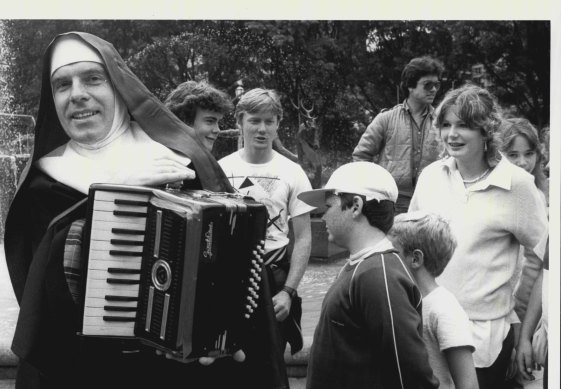
Fabian Lo Schiavo as Mother Inferior on the ABC program Encounters with reporter Vaughan Hinton and producer Brian Nicholis, 1985.Credit: ABC
From early on, media and public service had been in Vaughan Hinton’s DNA. His mother Miriam Vaughan had married William Percy Hinton and their trial separation began when Vaughan was six. Vaughan wrote in his memoir “Marrying my father was the worst thing my mother did, and it proved a disaster for her.” Vaughan was the eldest child of two, and his younger brother, Patrick, would also go on to a distinguished media career.
When Vaughan completed school at Toowoomba Grammar and his mother asked him what he wanted to do, he replied “I want to be a broadcaster”, and so it was in 1948 that he started his career in media as a cadet reporter on the Toowoomba Chronicle. He also worked with local ABC radio. From 1954, he completed his national service, becoming part of the 25th Infantry Battalion.
His mother brought him up in Christian Science, but he later chose to become an elder of the Presbyterian Church of St Stephen in Toowoomba and then editor of the Queensland Assembly’s publication The Messenger.
On discovering, in 1963, that there were still refugees from World War II living in camps waiting to secure entry visas into safer countries, Vaughan decided there must be something he could do to address this situation. So he took up a position with the Australian Council of Churches (ACC) to seek to make a positive difference, even though it meant moving with his wife, Elizabeth, and daughters Nicola and Caroline to Sydney.
At that time, the ACC was growing significantly in influence. The churches became deeply involved in social justice issues during the 1960s and 70s, particularly refugees. After the Second Vatican Council (1962-65), the Catholic Church finally became engaged with Protestant Churches in the Worldwide Christian Ecumenical movement.
In 1967, Vaughan started Force Ten, a joint new Roman Catholic-Protestant overseas aid program. In 1970, he was appointed national secretary of Australia’s first fully ecumenical organisation – the Joint Secretariat for Action for World Development. He was also seconded to the World Council of Churches in Geneva, the East Asia Christian Conference in Bangkok and the United Nations High Commissioner for Refugees in Geneva. His job involved significant travel – often to refugee centres, but also war zones.
For Vaughan personally, 1978 was a significant year – one in which he, though still married, was in the process of “coming out”. In 1978, homosexuality was still a jailable offence in Australia, so this decision had not only deeply emotional implications, but legal ones.
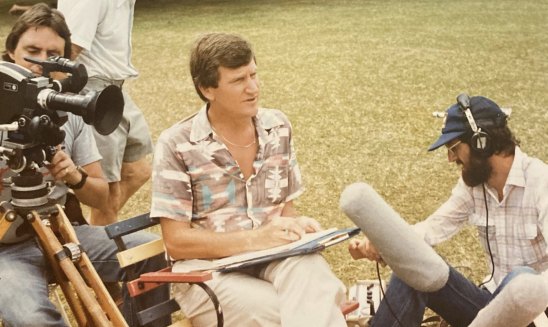
Broadcaster Vaughan Hinton on location.
It was also when Vaughan became a “78er” – the honorific used in the LGBTQI community to identify those who were at the first Sydney gay and lesbian Mardi Gras protest march and who endured the subsequent police crackdown and arrests. Although not known to each other at the time, Kym Skinner, his future partner of 45 years, was also at that protest march.
Somehow, Elizabeth and Vaughan negotiated their separation not only in the best interests of their daughters but some 25 years later, when his former wife was terminally ill, Vaughan and Kym opened their home to Elizabeth, and nursed her until her death.
Never happy to sit idly by, on retiring to the rural town of Monbulk in the Yarra Ranges, Vaughan and Kym became actively involved in the community, volunteering with the Monbulk Country Fire Authority (CFA). Such was their contribution that they were both awarded the CFA 15 years of service award and The Emergency Services Medal, Vic Fires 2009.
In recognition of the significance of his contribution to Australian TV broadcasting and the community more generally, he was awarded the Medal of the Order of Australia in 2014.
But ultimately, Hinton’s legacy is more than a career of significance. He leaves Kym and an extended family of children, grandchildren, great-grandchildren and friends who love and admire him. His true legacy is demonstrating how to care deeply about loved ones, and perhaps most importantly, to see the humanity in those who you don’t know and to do whatever you can to make a positive impact on their lives.
Noel Debien, Nicola Hepenstall and Caroline Hinton